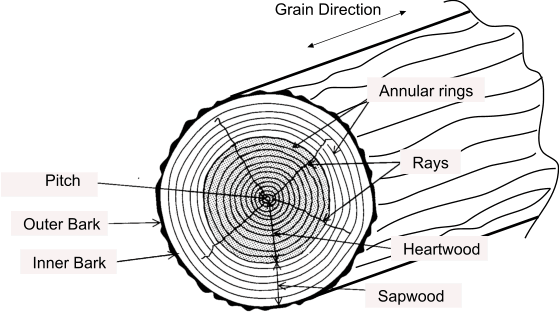Timber Index Page
Timber Properties
|
Introduction The notes below provide identify the factors which affect the properties of timber. More detailed information on wood types and properties is provided on webpage Wood
The timber used for construction, carpentry, joinery etch is obtained from the trunks of trees.
This part of the tree includes features required to structurally support the tree its branches and leaves
and withstand natural forces such as wind. The truck also includes a cellular structure to
transport moisture containing minerals and nutrients, sap between the roots and the upper branches and leaves. The density of is a very important factor affecting the strength of wood. The densest woods are generally the strongest. The density is also related to the stiffness and hardness e.g both these properties increase as the timber density increases. Softwoods...Softwoods are generally evergreens (coniferous) with needle-like leaves. They have the following characteristic features They grow relatively quickley and trees softwood trees can be felled after 30 years Hardwoods are generally broad-leaved (deciduous) that lose their leaves at the end of each growing season. The cell structure of hardwoods is more complex than softwoods with thick walled cells called fibres providing the structural support and thin walled cells called vessels providing the meddium for food condution along the trees. Hardwoods have the following characteristics affecting their use. The grow relatively slowly ,resulting in denser, stronger timbers. These tress take over 100 years to mature. Timber has high moisture content when first processed from the tree. The moisture content is reduced prior to the timber being used as a structural material. The drying off timber can be achieved using either of two methods 1) Air seasoning ...The timber is stacked in open sided weatherprrof containers is
such the air can freely circulated to all surfaces of the timber to promote drying. This process
can take considerable time and much space is required. Because of the nature of timber poor control of the drying process can result in a
range of defects including bowing, cupping, twisting and cracking. w = (m1 - m2 ) / m2 w = moisture content expressed as a percentage. The properties of timber are different in different directions. The elastic modulus and strength of wood is much greater in a direction along the grain than across the grain. If the grain is sloping at an angle to the direction of loading this can also have a marked effect of the strength of the timber. Stress/Strain relationship At low stress levels the strain is proportional to the strain. The strain is greater for a given stress at high moisture contents. However timber does have significant creep characteristics i.e over time at high constant stress values the strain will increase. In calculating strength of structures the duration of the loading is one of the factors to be considered. Thermal Properties Timber is a poor conductor of heat. The denser timbers are better conductors than the lighter timbers. Timber expands when heated but this is offset by the reduction in section resulting from the loss of moisture. Fire Resistance Timber compares favourably with other construction materials in terms of fire resistance. Small timber section may ignite easily and reduce to ash. However larger sections have significant resistance to fire because the surfaces initially in contact with the flames burn to charcoal which resists the further spread of the flame. Durability Timber does not corrode. It is however subject to weathering, chemical attack,
and fungal attack. The durability of timber varies depending on the wood species If
timber is kept dry or is continuously immersed in fresh water then decay shoud not be a problem. Timber immersed in seawater is at high risk of damage resulting from attack by molluscs. 1) Tar oil penetration - Creosote is a a typical tar oil presevative. This group
is used generally for external systems such as telegraph poles , fences, railway sleepers, timber enclosures
(garden sheds) etc. |
Links Providing information on Wood
|
|
Timber Index Page
